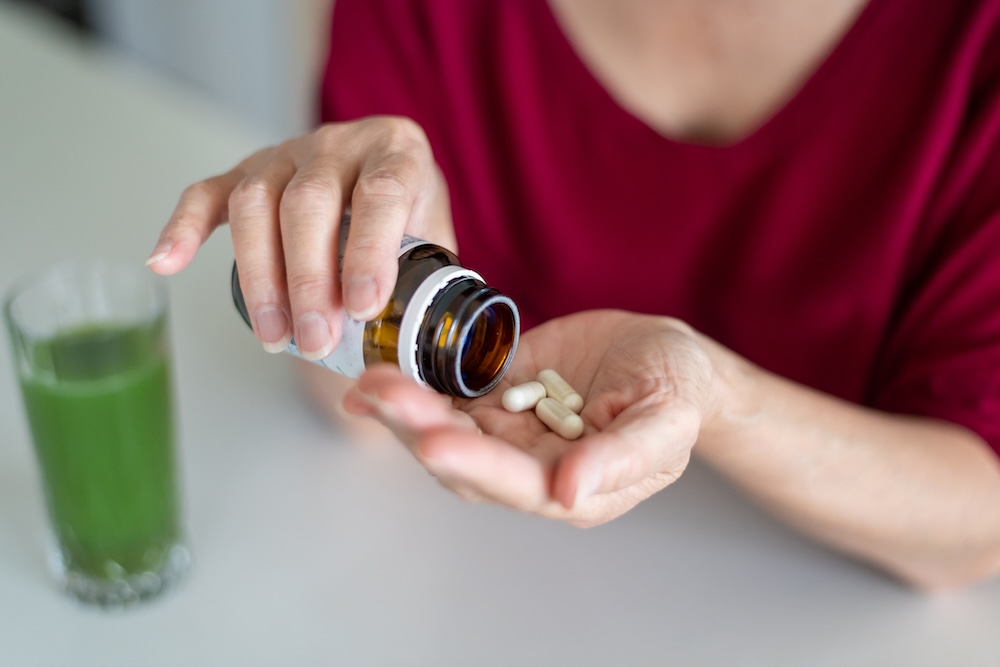Menopause brings with it a list of annoying and sometimes unpleasant symptoms but you can make your transition easier by picking the best foods for menopause. We’re not saying that improved nutrition is a complete one-size-fits-all solution for menopause, but it’s a good place to start if you want to find trigger patterns and alleviate symptoms. On top of this, what you eat during menopause can help reduce the long-term effects of lower estrogen levels, such as the risk of cardiovascular disease and osteoporosis.
We’ve shared recipes with foods to help menopause, which will take you from breakfast to dinner that are packed with the essential nutrients and superfoods to help boost energy, improve mood and help your long-term health when it comes to menopause and weight. Use them for inspiration when writing your shopping list or planning meals and start experimenting to see what helps you.
Find what you need quickly
Best foods for menopause shopping list
Go shopping for menopause foods that are high in protein and fiber, non-starchy carbs, healthy fats, water, and herbal teas while giving the alcohol and coffee aisle the swerve!
Protein
- Eggs
- Legumes
- Fish
- Lean meats
- Dairy products
These are key foods to help with menopause and more protein is needed at this stage of life than is recommended for an average adult. Try to make at least 1/4 of your plate at each meal a protein source – imagine a fist-sized portion. Eating high-quality protein at each meal will help you:
- Feel fuller for longer
- Preserve muscle mass
- Support your bone health
Carbohydrates
- Cauliflower
- Celery Root
- Eggplant
- Squash
- Rutabaga
- Zucchini
Carbohydrates get bad press but they are good menopause foods! You don’t need to cut them out of your diet to stay healthy, you just need to eat the right ones. Non-starchy, fibre-rich, carbohydrates keep your gut healthy, support your mood, aid sleep and give us energy.
Aim to fill half of your plate at lunch and dinner with non-starchy vegetables. These carbohydrates release sugars slowly into your bloodstream and won’t cause your blood sugar to spike. Avoiding blood sugar spikes is a good idea as they’ve been linked to a high incidence of hot flashes at menopause.
Try to avoid simple carbohydrates, processed foods, and those with added sugars (white bread, crackers, and baked goods). These foods cause your blood sugar and insulin levels to spike which can lead to fatigue, anxiety, and weight gain.
Fats
- Extra virgin olive oil
- Fatty fish (salmon, mackerel, sardines)
- Seeds (chia, flax, hemp)
Replace saturated fats with unsaturated, good fats. Healthy fats such as omega-3 fatty acids improve risk factors for heart disease, metabolic syndrome, and chronic inflammation.
Fibre
- Brown rice
- Whole grain bread
- Whole grain pasta
- Quinoa
- Legumes
- Oats
Fiber is a crucial part of rebalancing our hormones and are essential foods for menopause. They support the detoxing of your liver to stabilize your hormone levels and eliminate old hormones in your gut. Foods containing lots of fiber can help keep you feeling full for longer. The bonus is a diet high in fiber and whole grains has been linked to a reduced risk of heart disease and cancer.
Hydration
- Tap water
- Sparkling water
- Herbal teas
Head for the tap and drink up to two liters of water a day. Avoid caffeine, so loved by so many, as it increases your body’s cortisol and stress response and triggers hot flashes and night sweats for many people.
We’re not suggesting you give it up completely but use menopause as an opportunity to become mindful of your alcohol and caffeine intake. Use this time of your life to reset any dependencies you may have to improve your sleep and overall well-being. It’s not about removing your favorite things but adding quality to your life.
Alcohol should be consumed with caution. It adds calories, makes you dehydrated, and disrupts your sleep. It also affects blood-sugar balance and keeps your liver busy when it could be focusing on regulating hormone balance. Eliminating alcohol could be a big quick win in improving your symptoms.
Menopause foods meal planner
- Breakfast – energy-stabilizing almond pancakes
- Lunch – stress-fighting quinoa, roasted vegetables, and tofu
- Snack – brain-fog-busting dark chocolate chip cookies
- Dinner – healthy cauliflower mac and cheese
Breakfast: Energy-stabilising almond pancakes
Great for: Tiredness, irritability, weight gain, and hot flashes
Start your day with a boost of foods to help menopause, such as almond flour, oats, flax seeds, and fruit. This delicious recipe is easy to make and simple to adapt if you are vegan. All you have to do is substitute each egg for a tablespoon of chia seeds mixed with two tablespoons of water.
The secret to this recipe is magnesium-rich flax seeds, or linseeds, which are loaded with nutrients, protein, fiber, vitamins, and omega-3 fatty acids. These power-packed seeds can help reduce your hot flashes, regulate your blood sugar, and keep hunger under control.
Add in oats and you’re in for a great start to the day. Oats are one of nature’s amazing nutrient-dense foods that are rich in not only healthy carbohydrates and fiber, but vitamins, antioxidants, and minerals such as zinc and iron. This gluten-free whole grain can help stabilize your energy levels and make you feel fuller for longer.
And if that’s not enough, this recipe includes zinc-rich almond flour, which is great for improving your mood, and blueberries which are sometimes nicknamed ‘brain berries’ as they may help improve brain function and memory.
- Serves: 2
- Makes: 8 pancakes
- Prep time: 5 minutes
- Cook time: 15 minutes
Pancake ingredients
- 75g oats
- 60g almond flour
- 1 tbsp ground flaxseeds
- ½ tsp sea salt
- ½ tsp cinnamon
- 1 tsp baking powder
- ½ tsp baking soda
- 175 ml unsweetened almond milk (or milk of your choice)
- 2 eggs
- 1 tsp pure vanilla extract
- Coconut oil for frying
Topping ingredients
- 1 tbsp pure maple syrup
- 50 g blueberries
- A drizzle of almond butter and your favorite raw seeds
How to make
- Step 1: Starting with the eggs, vanilla, and milk, place all ingredients into a blender and blend until smooth.
- Step 2: Heat a frying pan on medium heat for about five minutes. Add coconut oil to the pan. If your pan is hot enough, it should melt instantly.
- Step 3: Into the frying pan, pour pancakes that are about 3 inches across.
- Step 4: After 3 – 4 minutes when the pancakes are becoming golden and small holes appear on the uncooked side, flip and cook for another 2 – 3 minutes.
- Serve: Stack the pancakes on a plate and top with blueberries, maple syrup, or any other toppings you prefer.
Nutrient profile per serving
- Cal: 459.5
- Total fat: 28.38 g
- Saturated: 6.77 g
- Trans: 0 g
- Polyunsaturated: 5.96 g
- Monounsaturated: 12.45 g
- Total carbohydrates: 37.05 g
- Dietary fiber: 9.6 g
- From sugar: 3.83 g
- Protein: 19.05 g
Lunch: Stress-fighting quinoa bowl
Great for: Tiredness, fatigue, hot flashes, digestion, and feeling full for longer
This delicious recipe packs a punch when it comes to foods to help menopause symptoms and is great for your lunch box when you’re on the go. Set yourself up for the afternoon with hormone-balancing tofu, stress-relieving quinoa, and antioxidant-rich vegetables.
Getting enough whole grains in your diet can help reduce menopause symptoms and provide you with essential vitamins, minerals, and fiber. Quinoa is one of nature’s superfoods and helps menopause symptoms. This plant-based source of protein is loaded with B vitamins which are great for the nervous system and reduce stress and anxiety. Quinoa also contains vitamin E for heart health, iron for overall good health, magnesium for your metabolism, and it’s high in fiber to make you feel fuller for longer.
- Serves: 2
- Prep time: 15 minutes
- Cook time: 45 minutes
Quinoa bowl ingredients
- 1 small red bell pepper, roughly chopped
- ½ small head of broccoli chopped into florets
- 1 small courgette, roughly chopped
- 1 small carrot, roughly chopped
- 1 small red onion, roughly chopped
- 280 g block of extra firm unflavoured tofu
- ½ cup uncooked quinoa
- 1 tsp olive oil
Quinoa bowl sauce ingredients
- 1 clove of garlic, minced
- 1 thumb of ginger, grated
- 30 ml tamari or soy sauce
- 1 tbsp sesame oil
- 2 tsp honey
- 1 tsp arrowroot starch or cornflour
Quinoa bowl toppings
- 2 tsp sesame seeds
- 1 pinch salt
- Handful fresh coriander
- ½ fresh lime
Prepare the veg and tofu
- Step 1: Preheat the oven to 356°F.
- Step 2: Chop all the vegetables and place them in a large mixing bowl.
- Step 3: Chop the tofu into squares about 0.5 inches thick, and chop diagonally to make triangles.
- Step 4: To make the sauce, whisk the sesame oil, soy sauce or tamari, honey, garlic, ginger, and arrowroot starch or cornflour in a small bowl.
- Step 5: Pour half of the sauce onto the chopped vegetables and toss. Space the vegetables out on a baking sheet.
- Step 6: Pour the other half of the sauce onto the chopped tofu, and arrange it on a small baking sheet.
- Step 7: Place both baking sheets into the oven for 40 minutes, flipping the tofu and vegetables after 30 minutes.
Prepare the quinoa
- Step 1: Rinse the quinoa thoroughly in a fine mesh strainer several times, and shake out as much of the excess water as possible.
- Step 2: Put the olive oil and quinoa into a saucepan, and toast on medium heat for about two minutes until all water has evaporated. Keep stirring.
- Step 3: Add 175 ml of water and a pinch of salt to the saucepan and cover.
- Step 4: Bring the heat up to high to boil the water. Once the water comes to a boil, let it simmer for about 15 minutes without removing the lid.
- Step 5: Let the quinoa sit for 5 minutes. If there is any remaining water in the pan, cook on low for a further 3 – 5 minutes.
- Serve: Place half of the quinoa in each bowl, and arrange roasted vegetables and tofu on top. Finish with sesame seeds, chopped coriander, and a wedge of lime.
Nutrient profile per serving
- Cal: 538
- Total fat: 25 g
- Saturated: 3 g
- Trans: 0 g
- Polyunsaturated: 8 g
- Monounsaturated: 11 g
- Total carbohydrates: 56 g
- Dietary fiber: 9 g
- From sugar: 14 g
- Protein: 24g
Snack: Craving busting dark chocolate chip cookie
Great for: Depression, digestion, blood pressure, water retention, tiredness, weight loss, itchy and dry skin
When we’re tired and irritable it’s easy to reach for the sugary snacks in the cupboard, but spend a little time making these yummy cookies and you can get the sweet taste you’re looking for, and give your body and brain a boost at the same time.
One of the surprising ingredients in these tasty cookies is antioxidant-rich zucchini, which not only makes them moist and yummy but is also one of the best foods to help menopause. These versatile veggies contain vitamin C for your immune system, fiber for gut health, potassium which helps your muscles work properly, and folic acid for healthy blood pressure and water levels.
Add good quality dark chocolate, which is at least 70% cacao, and you’ll be getting an excellent source of essential magnesium to help you sleep better and feel brighter. The fantastic news is that chocolate has also been proven to increase your serotonin levels which stabilize your mood, feelings of well-being, and happiness.
- Makes: 24 cookies
- Prep time: 10 minutes
- Cook time: 12 – 15 minutes
Wet cookie mixture ingredients
- 160 g finely shredded courgette from about 1 medium courgette
- 85 g coconut oil at room temperature
- 100 g coconut sugar
- 60 ml maple syrup or honey
- 60 ml Greek yogurt at room temperature
- 1 large egg at room temperature
- 1 tsp pure vanilla extract
Dry cookie mixture ingredients
- 225 g spelt or whole wheat flour
- 100 g oats
- 1½ tsp baking powder
- ½ tsp sea salt
- ¼ tsp baking soda
- ¼ tsp ground cinnamon
- 100 g dark chocolate chips or roughly chopped dark chocolate bar
How to make cookies
- Step 1: Preheat the oven to 356°F.
- Step 2: Finely grate and weigh the zucchini so you have 160 g, and then remove as much water as possible by pressing it down with kitchen paper.
- Step 3: Mix the flour, oats, baking powder, baking soda, sea salt, and cinnamon in a large bowl.
- Step 4: Cream together the coconut oil and sugar using a whisk or hand beaters, and then add the yogurt, vanilla, honey/maple syrup, and egg. Fold in the grated zucchini.
- Step 5: Combine the wet mixture with the dry mixture in the large bowl, and then fold in the chocolate chips or chopped dark chocolate bar.
- Step 6: Make dough balls by using a tablespoon or ice cream scoop, and place them on a greased baking sheet.
- Step 7: Bake for 12 – 15 minutes and cool on a wire rack.
Nutrient profile per cookie
- Cal: 137
- Total fat: 6 g
- Saturated: 4 g
- Trans: 0 g
- Polyunsaturated: 0 g
- Monounsaturated: 0 g
- Total carbohydrates: 17 g
- Dietary fiber: 2 g
- From sugar: 8 g
- Protein: 2 g
Dinner: Healthy cauliflower mac and cheese
Great for: Bone health, balancing your hormones, blood pressure, and weight gain
When comfort food is healthy. This version of macaroni and cheese swaps traditional bechamel sauce for a healthy and scrummy cauliflower-based puree and protein-rich lentil pasta.
Loading up on veg from the cabbage family during menopause is a great way to protect against cancer and heart disease, and these clever veggies are high in nutrients such as calcium, magnesium, and folic acid which supports bone health. Cauliflower is the key ingredient in this recipe and contains vital phytoestrogens, which balance your hormones and regulate your estrogen levels. This type of vegetable can help with your mood and memory function, boost your immunity and reduce your blood pressure. It’s a great choice when looking for foods to help with menopause.
By swapping traditional macaroni with lentil pasta you can enjoy a healthier alternative which is a good source of fiber, protein, and iron. Plus, there’s tasty garlic which also contains phytoestrogens to keep your hormones happy.
- Serves: 6
- Prep time: 15 minutes
- Cook time: 45 minutes
Mac and cheese ingredients
- 300 g cauliflower florets
- 150 ml stock
- 1 tbsp extra virgin olive oil or coconut oil
- 1 medium yellow onion, diced
- 2 cloves garlic, minced
- 2 tsp minced thyme
- 1 tsp English mustard
- ¼ tsp ground nutmeg
- ¼ cup nutritional yeast
- Salt and freshly ground black pepper to taste
- 250 g lentil pasta
- 250 g cheese of choice
- 25 g dried bread crumbs
- 3 tbsp nutritional yeast
- Cracked pepper
How to make mac and cheese
- Step 1: Preheat the oven to 356°f and fill a saucepan with water and bring to a boil.
- Step 2: Fry diced onion, garlic, and thyme, until soft and golden, and add the mustard and nutmeg.
- Step 3: Add the cauliflower florets and cover once the water comes to a boil. Cook for 5 – 6 minutes, until soft and cooked, and then strain.
- Step 4: Place the cauliflower and sauteed onion, garlic, and herbs into a blender, add stock, and blend to make a rich sauce.
- Step 5: Prepare the lentil pasta using the directions on the pack, cooking to the lower end of the suggested cook time, so that the pasta is al dente.
- Step 6: Mix the cauliflower sauce with the strained pasta and transfer to an 8×10 baking dish.
- Step 7: Top with grated cheese, breadcrumbs, and nutritional yeast (optional) along with a generous crack of black pepper.
- Step 8: Bake for 35 – 40 minutes, checking after 30 minutes and removing from the oven when bubbling and golden on top.
Nutrient profile per serving
- Cal: 435
- Total fat: 17 g
- Saturated: 9 g
- Trans: 0 g
- Polyunsaturated: 1 g
- Monounsaturated: 2 g
- Total carbohydrates: 39 g
- Dietary fiber: 7 g
- From sugar: 3 g
- Protein: 30 g
Find out more about the stages of menopause, and much more on our blog. Or learn about weight gain in our symptoms library.
Gradual weight gain, hot flashes, the dreaded night sweats, being tired during the day, getting grumpy for no reason, I got it all. But I found that what I ate affected how I felt more than ever. The hot flashes would stop for a while and I’d realize I’d eaten more greens and grains. If I ate a lot of sugary food I felt terrible. So I look out for healthy recipes to keep me happy





